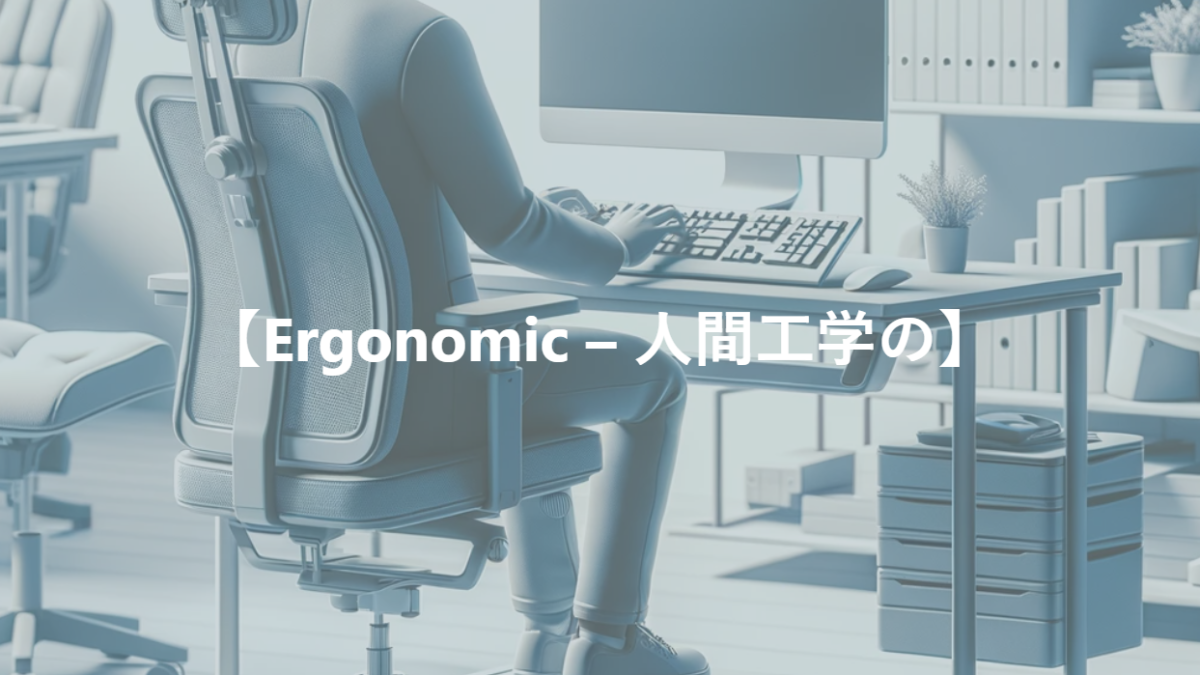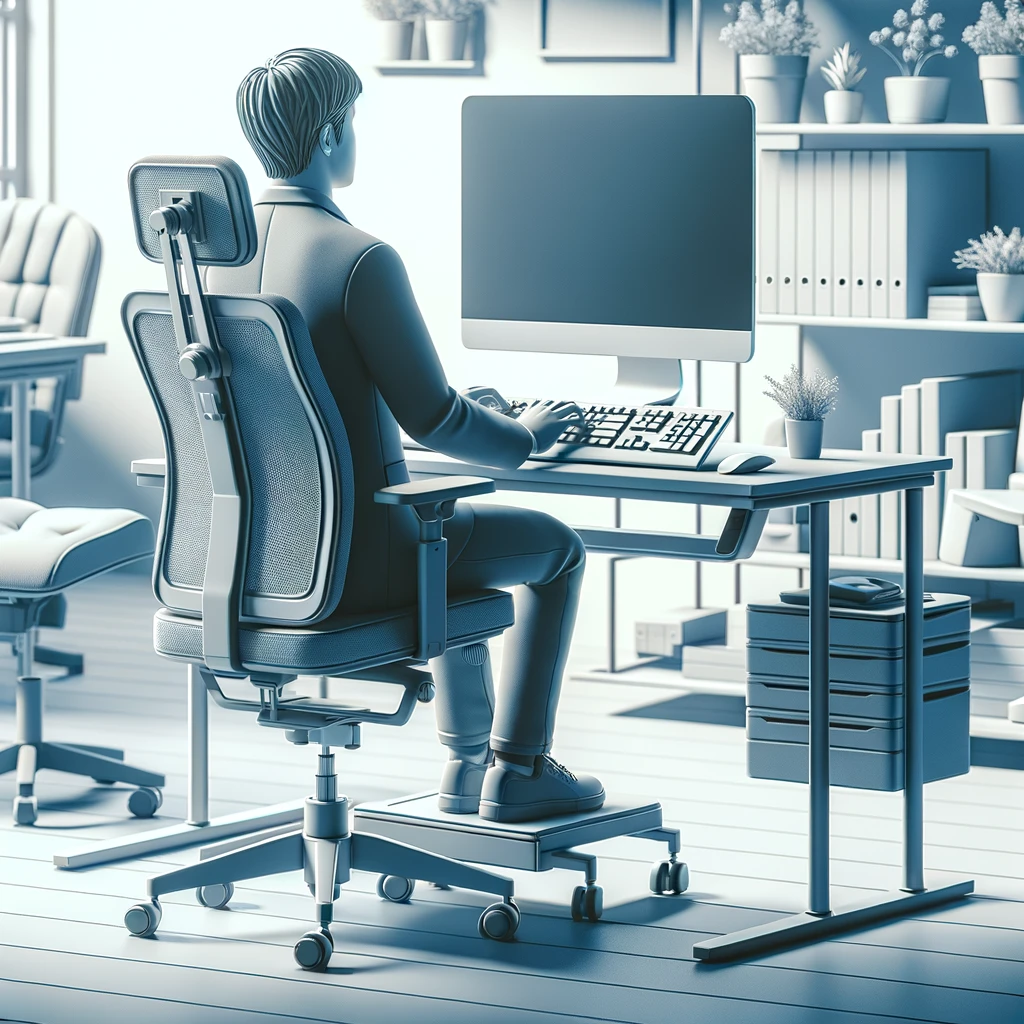語源・類義語・反対語・例文
【Ergonomic – 人間工学の】という単語の語源とか由来を知っていますか?
「Ergonomic」は、「Ergonomics」という単語から派生しており、人間工学を意味します。この単語は、ギリシャ語の「ergon」(仕事、労働)と「nomos」(法則、規則)の二つの単語を組み合わせたものです。つまり、「労働の法則」という意味になります。
人間工学とは、人間の能力と限界を考慮して、機械やシステム、作業環境を設計する科学のことを指します。この分野は、人間の安全性、快適性、効率性を向上させることを目的としています。人間工学の原則は、オフィスの椅子からキーボード、ツールの設計に至るまで、さまざまな製品や環境に応用されています。
「Ergonomic」や「Ergonomics」が広く使われるようになったのは20世紀中頃からで、特に工業デザイン、職場の安全、製品開発などの分野で重要視されています。この用語は、作業環境や製品が使用者の身体的な快適さや効率をどのようにサポートするか、という観点から使用されます。
“Ergonomic” is derived from the word “Ergonomics,” which means the study of human engineering. This term is a combination of two Greek words: “ergon” (work, labor) and “nomos” (laws, rules), essentially translating to “the laws of work.”
Ergonomics refers to the science of designing machines, systems, and work environments, taking into account human capabilities and limitations. The goal of this field is to enhance human safety, comfort, and efficiency. Ergonomic principles are applied to a wide range of products and environments, from office chairs and keyboards to the design of tools.
The widespread use of “Ergonomic” and “Ergonomics” began in the mid-20th century, particularly valued in the areas of industrial design, workplace safety, and product development. These terms are used to describe how work environments and products support the physical comfort and efficiency of the user.
この単語の類義語・反対語を教えてください。
類義語
- User-friendly: 利用者に優しい、使いやすい。製品やシステムが利用者の利便性を考慮して設計されていることを示します。
- Comfortable: 快適な。物理的な快適さを提供する製品や環境を指す場合に使われます。
- Efficient: 効率的な。作業の効率を向上させるように設計された方法やツールを指します。
- User-centric: ユーザー中心の。ユーザーのニーズや体験を中心に考えた設計を意味します。
- Intuitive: 直感的な。利用者が容易に理解し、使いこなせる製品やシステムを指します。
反対語
- Uncomfortable: 快適でない。使用時に不快感や不便を感じさせる製品や環境を指します。
- Inefficient: 非効率的な。作業の生産性を低下させるような方法やツールを指します。
- User-unfriendly: ユーザーに優しくない、使いにくい。利用者が使用しにくいと感じる製品やシステムを指します。
- Complicated: 複雑な。利用者が使用する上で難しさを感じる製品やシステムを指します。
- Inaccessible: アクセスしにくい。利用者が利用しにくい、またはアクセスしにくい設計の製品やシステムを指します。
似た単語で間違いやすい単語はありますか?
- Anatomic (解剖学的): 「Ergonomic」と混同されがちなこの単語は、人間の身体構造に基づいた設計を指します。解剖学的なデザインは、体の形状に合わせていますが、「Ergonomic」は使用時の快適さや効率性に焦点を当てています。
- Biomechanical (生体力学的): 生体力学は、生物の動きや力学的特性を研究する分野です。「Ergonomic」と関連していますが、より広範な生理学的、力学的側面に注目しており、直接的な使いやすさよりも身体機能に重点を置いています。
- Human Factors (ヒューマンファクター): この用語は「Ergonomic」と非常に密接に関連しており、しばしば同義で使用されます。しかし、ヒューマンファクターは人間の行動、能力、限界を全体的に考慮した設計に焦点を当てている点で、少し範囲が広いかもしれません。
- Usability (使用性): 使用性は製品やシステムがどれだけ簡単に使えるか、理解できるかに焦点を当てた概念です。「Ergonomic」とは異なり、主にインターフェースやソフトウェアの設計に関連して使われ、物理的な快適さよりも使いやすさが重視されます。
- Accessibility (アクセシビリティ): アクセシビリティは、障害を持つ人々を含むすべての人が製品やサービスを利用できるようにすることを指します。「Ergonomic」とは異なり、特定のユーザー群への配慮に重点を置いていますが、広義では両者は使用者のニーズに応えるための設計思想を共有しています。
この単語を使った例文をいくつか教えてください。
The new office chairs are designed with ergonomic features to provide better support for the spine and promote good posture.
(新しいオフィスチェアは、人間工学的な特徴を備えており、脊椎をより良くサポートし、正しい姿勢を促進します。)
The smartphone’s ergonomic design ensures that it fits comfortably in the hand and allows for easy one-handed operation.
(スマートフォンの人間工学的なデザインにより、手に快適に収まり、片手での操作が容易に行えます。)
The factory implemented ergonomic improvements in the assembly line, reducing strain and fatigue among the workers.
(工場では、組み立てラインにおいて人間工学的な改善を行い、労働者の負担や疲労を軽減しました。)
The office workspace was rearranged to create an ergonomic setup, with adjustable desks and ergonomic chairs for employee well-being.
(オフィスのワークスペースは人間工学的な配置となり、従業員の健康と快適性を考慮した、高さ調節可能なデスクと人間工学的な椅子が導入されました。)
The laptop features an ergonomic keyboard layout to reduce the risk of repetitive strain injuries for frequent typists.
(そのノートパソコンは、頻繁にタイピングをする人に対して、繰り返しの負荷による怪我のリスクを軽減するために、人間工学的なキーボード配置を備えています。)
【Ergonomic – 人間工学の】のコロケーション
- Ergonomic design (人間工学に基づいた設計): 製品や作業環境が、使用者の身体的な快適さや効率性を考慮して設計されていることを意味します。例えば、長時間の使用でも疲れにくい椅子やキーボードなどがこれに該当します。
- Ergonomic chair (人間工学に基づいた椅子): 長時間座っていても快適で、背中や腰への負担を軽減するよう設計された椅子を指します。オフィスワークなどで一般的に使用されます。
- Ergonomic keyboard (人間工学に基づいたキーボード): 手や腕への負担を減らし、タイピングの効率を高めるために特別に設計されたキーボードです。キーの配置や形状が通常のキーボードと異なることが多いです。
- Ergonomic assessment (人間工学的評価): 職場や製品の人間工学に基づいた設計の適切さを評価するプロセスです。作業環境や製品が使用者の健康や効率にどのように影響するかを分析します。
- Ergonomic mouse (人間工学に基づいたマウス): 手や腕の疲労を軽減し、長時間の使用でも快適に操作できるように設計されたコンピュータマウスです。形状が手に自然にフィットするよう工夫されています。
「Ergonomic」、つまり人間工学に基づいた設計は、私たちの日常生活や職場環境において、快適さと効率性を向上させるための重要な要素です。この概念は、使用者の身体的、精神的な負担を最小限に抑えることを目的としており、様々な製品や環境設計に応用されています。
人間工学に基づいた設計、つまり「Ergonomic design」は、製品や職場が使用者の健康や生産性を考慮して作られていることを示します。例えば、長時間の作業でも疲れにくい「Ergonomic chair」や、手や腕への負担を減らす「Ergonomic keyboard」といった製品は、この原則に基づいています。
さらに、「Ergonomic assessment」は、職場や製品がどれだけ人間工学の観点から適切に設計されているかを評価するプロセスです。これにより、作業環境や製品の改善点が明らかになり、より快適で健康的な使用が可能になります。
また、「Ergonomic mouse」のようなデバイスは、長時間のコンピュータ作業による手や腕の疲労を軽減します。これらの製品は、形状が手に自然にフィットするように工夫されており、使用者の快適性を大幅に向上させます。
これらのコロケーションを通じて、「Ergonomic」の概念が、私たちがより快適で健康的な生活を送るためにいかに役立つかがわかります。人間工学に基づいた製品や環境設計は、私たちの生活の質を高め、作業効率を改善するための鍵となります。
“Ergonomic,” or based on the principles of human engineering, plays a crucial role in enhancing comfort and efficiency in our daily lives and work environments. This concept aims to minimize physical and mental strain on users and is applied across various products and environmental designs.
Ergonomic design indicates that products or workplaces are created with the health and productivity of the user in mind. For example, products like ergonomic chairs, designed for extended periods of work without causing fatigue, and ergonomic keyboards, which reduce strain on the hands and arms, are based on these principles.
Furthermore, ergonomic assessment is the process of evaluating how well a workplace or product meets ergonomic standards. This reveals areas for improvement in work environments and products, enabling a more comfortable and healthy usage.
Devices such as ergonomic mice also alleviate fatigue in the hands and arms caused by long hours of computer work. These products are cleverly designed to naturally fit the hand, significantly enhancing user comfort.
Through these collocations, we see how the concept of “ergonomic” is instrumental in helping us lead more comfortable and healthier lives. Ergonomically designed products and environments are key to improving our quality of life and work efficiency.
ergonomicを使った文法問題
- The company invested in _____ chairs to improve employee comfort and reduce the risk of work-related injuries.
- (A) ergonomical
- (B) ergonomics
- (C) ergonomically
- (D) ergonomic
解答と解説: (D) ergonomic
解説: 空欄には名詞chairsを修飾する形容詞が入ります。ergonomicは「人間工学の」という意味の形容詞です。
- The new office design incorporates _____ principles to create a more comfortable and productive workspace.
- (A) ergonomical
- (B) ergonomics
- (C) ergonomically
- (D) ergonomic
解答と解説: (D) ergonomic
解説: 空欄には名詞principlesを修飾する形容詞が入ります。ergonomicは「人間工学の」という意味の形容詞です。
- The keyboard is _____ designed to reduce strain on the wrists and hands.
- (A) ergonomical
- (B) ergonomics
- (C) ergonomically
- (D) ergonomic
解答と解説: (C) ergonomically
解説: 空欄には動詞designedを修飾する副詞が入ります。ergonomicallyは「人間工学的に」という意味の副詞です。
- The company offers training sessions on _____ to help employees set up their workstations properly.
- (A) ergonomical
- (B) ergonomics
- (C) ergonomically
- (D) ergonomic
解答と解説: (B) ergonomics
解説: 空欄にはonの後に続く名詞が入ります。ergonomicsは「人間工学」という意味の名詞です。
- Investing in _____ furniture can lead to increased employee satisfaction and productivity.
- (A) ergonomical
- (B) ergonomics
- (C) ergonomically
- (D) ergonomic
解答と解説: (D) ergonomic
解説: 空欄には名詞furnitureを修飾する形容詞が入ります。ergonomicは「人間工学の」という意味の形容詞です。


